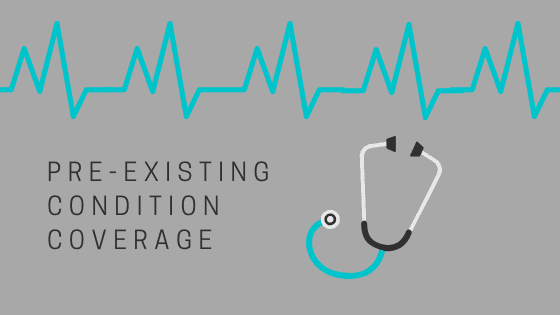Pre-existing medical conditions — like high blood pressure, diabetes, and asthma — are common. Most of us either have a pre-existing condition or live with someone who does. The health care system needs to work for everyone, including people who aren’t in perfect health.
There’s been lots of recent talk about protecting people with pre-existing medical conditions. Many candidates pledged support for coverage of pre-existing conditions during the November 2018 elections. Since then, Texas Governor Greg Abbott has said that Texas will strive to “ensure that Texans with pre-existing conditions are protected.” These assurances reflect the strong public support for the topic – 3 in 4 Americans say that it is “very important” to maintain Affordable Care Act protections ensuring the people with pre-existing conditions can’t be denied coverage or charged more, per the Kaiser Family Foundation.
Much of the attention on pre-existing conditions has been in response to the lawsuit that Texas Attorney General Ken Paxton is leading, seeking to end the Affordable Care Act. The first court to rule on the case sided with the Texas AG, but the case is sure to be tied up in court for months or years, and for now, the Affordable Care Act remains the law of the land.
What does it mean to protect people with pre-existing conditions?
People who already know they’ll need ongoing health care, need the following assurances about coverage:
- Health insurance companies can’t turn you down or charge you more due to your health status;
- Insurance policies can’t exclude coverage for pre-existing conditions; and
- Policies have comprehensive coverage. A person with asthma needs inhalers covered and someone with cancer needs oncology benefits. Having an insurance card in your wallet is only meaningful if it covers the health care you will need.
If you buy insurance on your own (as opposed to receiving coverage through a job), you didn’t have any of these guarantees before the Affordable Care Act. Repeal of the Affordable Care Act would sweep away those protections along with other protections Americans have come to rely on.
What can Texas do today to protect people with pre-existing conditions?
The Affordable Care Act is still the law of the land, and its protections remain in place. However, affordability of coverage is a challenge, especially for two groups of people in Texas: (1) people who make too much to qualify for Health Insurance Marketplace subsidies (more than $83,000/year for a family of three) and (2) low-wage adults in the “Coverage Gap” who earn too little for Marketplace subsidies, but do not qualify for Medicaid.
Regardless of the eventual outcome of the lawsuit, there are three actions Texas can and should take today to lower the costs of health insurance for people with pre-existing conditions.
1. Texas should place reasonable limits on “short-term” plans, as 23 states already have. These skimpy plans were initially designed to fill short gaps between other coverage, but they can now be offered as year-round coverage with policies that last as long as 3 years (making “short-term” a misnomer).
These plans violate all three provisions above. They can deny coverage to people in less-than-perfect health and contain broad exclusions of any health care for a pre-existing condition. These plans often lack coverage for prescription drugs, mental health care, preventive care, and other necessary health care. In other words, short-term plans don’t compete with regular health insurance on an even playing field. They play by vastly different rules.
As short-term plans cherry-pick the healthiest people, the pool of people covered in traditional insurance—the only type available to people with pre-existing conditions — becomes sicker on average, causing premiums to rise and insurers to flee. In this way, even though a person with a pre-existing condition is unlikely to be able to buy a short-term plan, they are still harmed by them.
Texas policymakers cannot truly claim progress on pre-existing conditions protections while allowing short-term plans to proliferate and drive up costs of coverage for people with pre-existing conditions. Texas should strike a balance. It should ensure short-term plans are available to fill temporary gaps in coverage of three or six months, as several other states
2. Texas should apply for a “1332 waiver” to collect federal funding that will help lower the price tag for good coverage that includes pre-existing condition protections. Seven states, including Alaska, Wisconsin, and Maine, have already taken this step, and they expect premiums for comprehensive coverage to drop as much as 30 percent for people who don’t have access to job-based insurance and buy coverage on their own. These states have set a “reinsurance system” that uses federal funding to help pick up the tab for people with the costliest health care, allowing insurers to reduce premiums. Texas should only pursue a 1332 waiver that brings down premiums for and boosts enrollment in traditional health insurance that has good coverage and cannot deny coverage or charge more to people with pre-existing conditions.
3. Close the Coverage Gap. Texas still has to deal with the fact that we are currently leaving low-wage Texans in the Coverage Gap because state leaders keep turning down Medicaid expansion funding. Extending coverage to low-wage Texans would improve their access to health care and financial security, and as an added bonus, Medicaid has strong pre-existing condition protections.
But what if the courts eventually strike down the entire Affordable Care Act?
If the courts eventually strike down the Affordable Care Act, narrowly-focused state action to replace pre-existing conditions protections would be a wholly inadequate response. Nearly 1.1 million Texans just enrolled in Marketplace coverage for 2019. In 2018, 9 in 10 Texas Marketplace enrollees got a premium subsidy to lower their costs – which amounts to a nearly $5 billion-a-year investment in connecting Texans to coverage. Without this federal funding, most enrollees would be unable to afford coverage regardless of whether pre-existing condition protections are in place or not.
